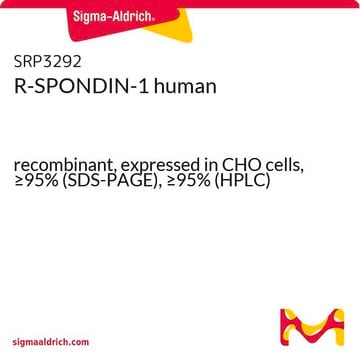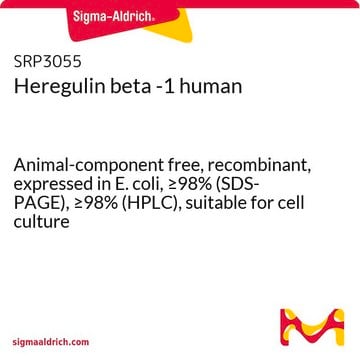SRP4675
Noggin human
recombinant, expressed in E. coli, ≥95% (SDS-PAGE), ≥95% (HPLC)
Synonym(s):
NOG, SYM1, SYNS1
Sign Into View Organizational & Contract Pricing
All Photos(1)
About This Item
Recommended Products
General description
Noggin (NOG) belongs to a group of diffusible proteins which bind to ligands of the TGF (transforming growth factor)-β family and regulate their activity by inhibiting their access to signaling receptors. The protein is secreted and exists as a disulfide-linked homodimer. The gene NOG is mapped to human chromosome 17q22. Recombinant human Noggin is a 23.1kDa non-disulfide-linked homodimer consisting of a total of 206 amino acid residues.
Application
Noggin (NOG) human has been used as a BMP antagonist.
Biochem/physiol Actions
Noggin (NOG) was originally identified as a BMP-4 (bone morphogenetic protein 4) antagonist whose action is critical for proper formation of the head and other dorsal structures. Consequently, Noggin has been shown to modulate the activities of other BMPs including BMP-2,-7,-13, and -14. Transgenic mice over-expressing Noggin in mature osteoblasts display impaired osteoblastic differentiation, reduced bone formation, and severe osteoporosis. In mice, loss of noggin causes malformations in skeletal system. In mouse noggin is associated with tissue patterning by participating in cell differentiation, cell proliferation and apoptosis in the developing embryo. Mutations in the gene is associated with several disorders, including proximal symphalangism, multiple synostoses, tarsal/carpal coalition syndrome and Teunissen–Cremers syndrome. It is a gene which is also linked with conductive hearing loss. Polymorphism in the gene might be associated with reduced risk of nonsyndromic cleft lip with or without cleft palate (NSCLP).
Physical form
Lyophilized without any additives.
Reconstitution
Centrifuge the vial prior to opening. Avoid freeze-thaw cycles.
Reconstitute in water to a concentration of 0.1 to 1.0 mg/mL. Note: Due to solubility reasons the protein should be kept at low pH. This solution can then be diluted into other aqueous buffers.
Storage Class Code
11 - Combustible Solids
WGK
WGK 3
Flash Point(F)
Not applicable
Flash Point(C)
Not applicable
Certificates of Analysis (COA)
Search for Certificates of Analysis (COA) by entering the products Lot/Batch Number. Lot and Batch Numbers can be found on a product’s label following the words ‘Lot’ or ‘Batch’.
Already Own This Product?
Find documentation for the products that you have recently purchased in the Document Library.
Customers Also Viewed
Noggin heterozygous mice: an animal model for congenital conductive hearing loss in humans.
Hwang CH and Wu DK
Human Molecular Genetics, 17, 844-853 (2008)
Association between NOGGIN and SPRY2 polymorphisms and nonsyndromic cleft lip with or without cleft palate.
Song T
American Journal of Medical Genetics. Part A, 167A, 137-141 (2015)
Nonsyndromic cleft lip with or without cleft palate: Increased burden of rare variants within Gremlin-1, a component of the bone morphogenetic protein 4 pathway.
Al Chawa T
Birth Defects Research Part A: Clinical and Molecular Teratology, 100, 493-498 (2014)
Impaired osteoblastic differentiation, reduced bone formation, and severe osteoporosis in noggin-overexpressing mice.
Wu XB
The Journal of Clinical Investigation, 115, 1390-1390 (2005)
Huanju Bai et al.
Scientific reports, 9(1), 10494-10494 (2019-07-22)
There is a strong capacity for hair cell regeneration after damage in the inner ear of non-mammals. However, mammalian hair cells are substantially unable to regenerate. To obtain insights into the mechanism of this difference, we analyzed the transcriptomic changes
Our team of scientists has experience in all areas of research including Life Science, Material Science, Chemical Synthesis, Chromatography, Analytical and many others.
Contact Technical Service








![[Leu15]-Gastrin I human ≥95% (HPLC)](/deepweb/assets/sigmaaldrich/product/structures/153/342/d4cb3dd7-13f1-46cf-8d1f-3907a5de7a83/640/d4cb3dd7-13f1-46cf-8d1f-3907a5de7a83.png)



